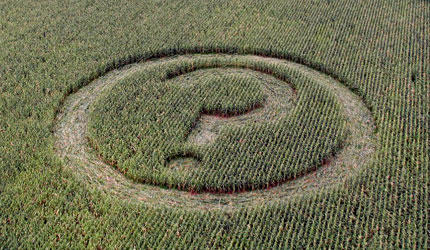
A crop circle in the shape of a question mark adorns a field of GM maize in Mexico
Over the past few weeks, strange signs have been appearing in fields across the world. In France and Mexico, crop circles have imprinted themselves on the landscape but we know for certain it isn't the work of aliens but Greenpeace protesters making sure the world can see exactly where genetically modified (GM) crops are growing.
Earlier this year, Greenpeace France published the locations of fields where GM maize is being grown commercially, but the courts order forced them to remove the information despite an EU law which states that such information should be publicly available. The map has since been published on the Greenpeace International website, but to make sure no one could mistake what was growing in the fields a giant 'X' was carved into one of the fields in question.
Then on Thursday in Mexico, GM maize was the target again but this time an enormous question mark graced the field where it was growing. Contamination of conventional maize from GM crops is of particular concern in Mexico as the country is the native home to a huge number of maize varieties, and such contamination is a threat to diversity within the species.
The Mexican crop circle was the work of John Lundberg, a professional cropcircle maker, and here he talks about his latest work and why he decided to become involved with Greenpeace.
"For years I'd thought that crop circles would be an ideal medium for promoting Greenpeace's GM campaign. The crop circles generate an alien mystique, encouraging people to consider the unknown.
"Greenpeace's GM campaign aims to prevent alien organisms from contaminating our plants and food, while raising awareness of the unknown consequences that could arise from such material entering the food chain. This combination of mystery, creativity and an underlying message perfectly reflects the work that Greenpeace is doing worldwide. It was also embodied in the formation we created for them - a 65-metre circle with a question mark at its centre.
"For thousands of years, maize or corn has been an essential food for the people of Mexico - it also plays an integral part in their culture and religion. Unfortunately, in recent years the maize has been tainted by GM varieties entering the country and being planted by unaware farmers. As a result, normally GM-free maize is showing signs of genetic contamination.
"So the question mark conveys a simple message - contamination is happening, but nobody knows exactly where it is taking place, nor where it could lead for the wider environment.
"A day after our crop circle creation we were transported to a tiny village called Cuanajo in the state of Michoacan. A celebration was held to honour the regions GE free status. The festival was an amazing cultural experience, each type of maize has a purpose. Maize for tortillas, tamales, atoles, pozole, animal feed and also to create handcrafts which they sell in market stalls.
"Protecting this precious diversity is paramount for the people, regional government, scientists and environmental groups who have all worked together to cement the region as GM free. Other surrounding regions are also interested in following this example to create their own GM free zones.
"The more I find out about the issues surrounding GM, especially within Mexico, the happier I am to have been involved in this project. With literally thousands of different strains of maize in Mexico, it's vitally important for both its people, and the rest of the world, to keep the seeds clean and maintain their variety.
"Working with Greenpeace in Mexico was a rewarding and fun experience - even during the rainy season! Circlemakers hope to continue our relationship with Greenpeace and I also hope that Mexico can successfully rid itself of genetic contamination and keep its maize GE-free."
John Lundberg is a British artist and documentary filmmaker. In the early 1990s he founded Circlemakers, a UK-based arts collective famous for covertly creating hundreds of the world's most spectacular crop circles. They've created crop circle in the UK, US, New Zealand, Japan, across continental Europe and now in Mexico.

